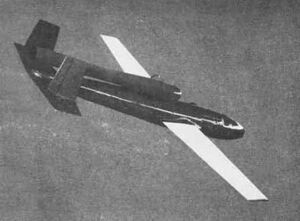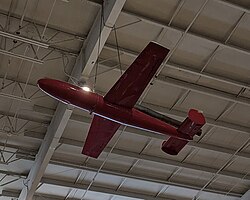Engineering:Globe KD2G Firefly
| KD2G Firefly | |
|---|---|

| |
| KD2G-1 | |
| Role | Target drone |
| National origin | United States |
| Manufacturer | Globe Aircraft Corporation |
| First flight | 1946 |
| Retired | ~1954 |
| Primary user | United States Navy |
| Developed from | Globe KDG Snipe |
| Developed into | Globe KD6G Firefly |
The Globe KD2G Firefly was a pulsejet-powered United States target drone, built by the Globe Aircraft Corporation for operation by the United States Navy in the late 1940s, seeing operational use into the mid-1950s.
Design and development
The KD2G was a mid-wing, twin-tailed aircraft of similar design to the KDG Snipe which Globe was already supplying to the Navy. A single McDonnell PJ42 pulsejet engine was mounted atop the rear of the fuselage.[1] The fuselage was constructed of steel tubing with a duralumin monocoque covering; dural was also used for the flying surfaces.[2] The KD2G was equipped with radio control with an effective range of 6,000 yards (5,500 m); it could be launched using a catapult, or launched aerially from JD-1 or F7F-2D aircraft.[2] Recovery, if it survived its mission, was by a 32-foot (9.8 m) diameter parachute; the Firefly was designed to be able to float for up to 15 minutes in the event of a water landing.[2]
Operational history
First flying as the XKD2G-1 prototype during 1946, the KD2G-1 entered service with the United States Navy during 1947. The improved KD2G-2, powered by a Solar PJ32 pulsejet, began production in 1950;[1] it was the first successful jet-powered target drone to be developed following the end of World War II.[3] The KD2G remained in service through the mid-1950s, being replaced by the KD6G.[1]
Variants
- XKD2G-1
- Prototype with McDonnell PJ42 engine.[1]
- KD2G-1
- Production version of XKD2G-1 with 28-volt electrical system.[1]
- KD2G-2
- Improved production model with Solar PJ32 engine.[1]
Surviving aircraft

A KD2G-2 is displayed at the Aircraft Pavilion of the Battleship Memorial Park in Mobile, Alabama.[citation needed]
Specifications (KD2G-2)
Data from Standard Aircraft Characteristics[2]
General characteristics
- Crew: None
- Length: 12 ft 3 in (3.73 m)
- Wingspan: 11 ft 8 in (3.56 m)
- Height: 2 ft 3 in (0.69 m)
- Wing area: 20.66 sq ft (1.919 m2)
- Empty weight: 191 lb (87 kg)
- Gross weight: 311 lb (141 kg)
- Max takeoff weight: 320 lb (145 kg)
- Fuel capacity: 20 US gallons (76 l; 17 imp gal)
- Powerplant: 1 × Solar PJ32-S-4 pulsejet, 107 lbf (0.48 kN) thrust
Performance
- Maximum speed: 240 mph (390 km/h, 210 kn)
- Stall speed: 62 mph (100 km/h, 54 kn) power on
- Combat range: 100 mi (161 km, 87 nmi)
- Endurance: 26 minutes
- Rate of climb: 2,180 ft/min (11.1 m/s) at sea level
- Time to altitude: 2 minutes to 4,000 feet (1,200 m); 4.9 minutes to 8,000 feet (2,400 m)
- Wing loading: 14.9 lb/sq ft (73 kg/m2)
Avionics
- AN/ARW-26Y radio control system
See also
Related development
- Globe KDG Snipe
- Globe KD3G Snipe
- Globe KD6G Firefly
Aircraft of comparable role, configuration and era
Related lists
References
Citations
Bibliography
- Parsch, Andreas (2005). "Globe KD2G Firefly". Directory of U.S. Military Rockets and Missiles. designation-systems.net. http://www.designation-systems.net/dusrm/app1/kd2g.html. Retrieved 2013-02-12.
- White, Maxwell (1992). Datelines, a history of Navy missile testing at Point Mugu, California. Point Mugu, CA: Naval Air Warfare Center, Weapons Division.
External links
 |

